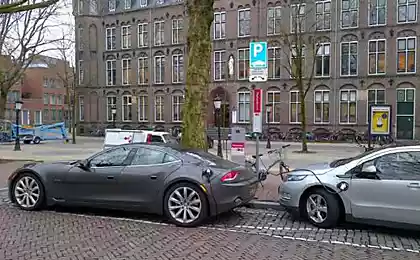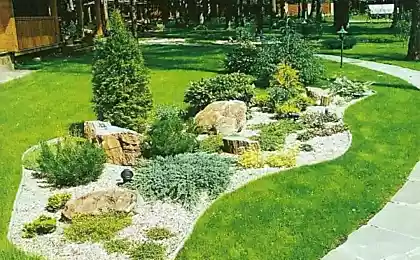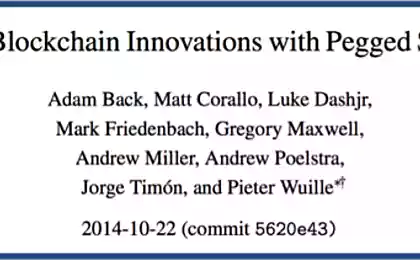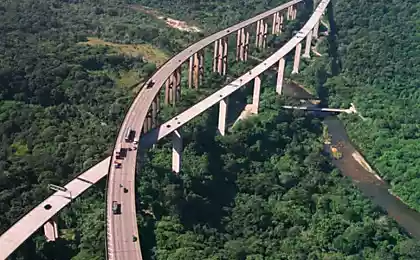501
Smart roads in the Netherlands
Dutch designer Daan Roosegarde (Daan Roosegaarde in collaboration with Heijmans has developed a futuristic eco-project "Smart Highway" or "intelligent highway". Ultra-modern track will be equipped with interactive lighting, by means of which the pavement to provide drivers with information on weather conditions and at the same time recharges the batteries of electric vehicles or hybrids. The first hundred metres of such a road will appear in the in the province of Brabant (Branbant) in the Netherlands for next summer.


"Smart highway" does not need external light sources, because the dark will glow itself road markings. Solar energy, fluorescent dye will accumulate during the day and will be clearly visible even 10 hours after sunset.
On the road, however, is provided by led lights, powered by miniature windmills. But thanks to the mounted motion sensors and it will be included only as a passing vehicle – and then off to the next car. This alignment will allow you to save on lighting truly astronomical amounts that can be spent on the search for new environmentally friendly solutions.
The developers also intend to apply thermal inks to create indicators of weather on the roadway: when the temperature drops and the risk of ice on the pavement will show up glowing red snowflakes. Under the roadway will accommodate an induction coil, which will interact with similar devices on the bottom of electric and hybrid cars, charging their batteries.

Surprisingly, but the project from "Studio Roosegaarde" no fundamentally new developments – but the project still is a big step in the future. Daan Roosegarde said that photoluminescent paint is no longer a novelty, and the interest in "intelligent" transport infrastructure appeared three decades ago. What truly is lacking is a real application of innovation in practice, which could bring more comfort and safety in practice driving.
So far, this technology we only saw in science fiction films and computer games, and many did not believe that they can be moved from monitor to the real world. "My goal is to prove the opposite," said the designer in an interview with Wired. Partly this promise has been fulfilled: the experimental part of the road was able to see all the visitors of the Danish Design Week (Dutch Design Week), which in October took place the presentation of the project "Smart Highway". The event was more than successful: "smart highway" was recognized as "Best project for the future" and awarded by "Dutch Design Awards".

In the future, "Studio Roosegaarde" plan to provide similar route to the West coast States, where Google is testing its unmanned hybrids. There is also the view that the "smarter" it would be not only roads, but also pedestrian roads: unnecessary bruises from falls on the ice yet no one was happy. If you think on a larger scale, the road to the fluorescent lighting would serve a useful service in many countries – especially where there are regular incidents of power outages (for example, in India).

Source: /users/104


"Smart highway" does not need external light sources, because the dark will glow itself road markings. Solar energy, fluorescent dye will accumulate during the day and will be clearly visible even 10 hours after sunset.
On the road, however, is provided by led lights, powered by miniature windmills. But thanks to the mounted motion sensors and it will be included only as a passing vehicle – and then off to the next car. This alignment will allow you to save on lighting truly astronomical amounts that can be spent on the search for new environmentally friendly solutions.
The developers also intend to apply thermal inks to create indicators of weather on the roadway: when the temperature drops and the risk of ice on the pavement will show up glowing red snowflakes. Under the roadway will accommodate an induction coil, which will interact with similar devices on the bottom of electric and hybrid cars, charging their batteries.

Surprisingly, but the project from "Studio Roosegaarde" no fundamentally new developments – but the project still is a big step in the future. Daan Roosegarde said that photoluminescent paint is no longer a novelty, and the interest in "intelligent" transport infrastructure appeared three decades ago. What truly is lacking is a real application of innovation in practice, which could bring more comfort and safety in practice driving.
So far, this technology we only saw in science fiction films and computer games, and many did not believe that they can be moved from monitor to the real world. "My goal is to prove the opposite," said the designer in an interview with Wired. Partly this promise has been fulfilled: the experimental part of the road was able to see all the visitors of the Danish Design Week (Dutch Design Week), which in October took place the presentation of the project "Smart Highway". The event was more than successful: "smart highway" was recognized as "Best project for the future" and awarded by "Dutch Design Awards".

In the future, "Studio Roosegaarde" plan to provide similar route to the West coast States, where Google is testing its unmanned hybrids. There is also the view that the "smarter" it would be not only roads, but also pedestrian roads: unnecessary bruises from falls on the ice yet no one was happy. If you think on a larger scale, the road to the fluorescent lighting would serve a useful service in many countries – especially where there are regular incidents of power outages (for example, in India).

Source: /users/104























